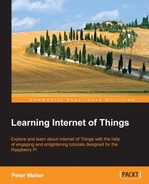Universal Plug and Play (UPnP) is a protocol or an architecture that uses multiple protocols, helps devices in ad hoc IP networks to discover each other, detects services hosted by each device, and executes actions and reports events. Ad hoc networks are networks with no predefined topology or configuration; here, devices find themselves and adapt themselves to the surrounding environment. UPnP is largely used by consumer electronics in home or office environments. In this chapter, you will learn:
- The basic UPnP device architecture
- How to create a UPnP device and service description documents
- How to implement a UPnP service
- How to discover devices and subscribe to events through them
UPnP is a very common protocol. It is used by almost all network-enabled consumer electronics products used in your home or office, and as such, it is a vital part of Digital Living Network Alliance (DLNA). The standard body for UPnP is the UPnP Forum (upnp.org). UPnP is largely based on an HTTP application where both clients and servers are participants. This HTTP is, however, extended so that it can be used over TCP as well as UDP, where both use unicast addressing (HTTPU) and multicast addressing (HTTPMU).
Discovery of devices in the network is performed using Simple Service Discovery Protocol (SSDP), which is based on HTTP over UDP, and event subscriptions and notifications are based on General Event Notification Architecture (GENA). Both SSDP and GENA introduce new HTTP methods to search, notify and subscribe to and unsubscribe from an event. Devices find each other by notifying the network of their existence using multicast addressing and the available services. However, they can also search for the network using multicast addressing for certain types of devices or services. Actions on services are called using SOAP web service calls.
UPnP defines an object hierarchy for UPnP-compliant devices. Each device consists of a root device. Each root device can publish zero or more services and embedded devices. Each embedded device can iteratively publish more services and embedded devices by itself. Each service in turn publishes a set of actions and state variables. Actions are methods that can be called on the service using SOAP web service method calls. Actions take a set of arguments. Each argument has a name, direction (if it is input or output), and a state variable reference. From this reference, the data type of the argument is deduced. State variables define the current state of a service, and each one has a name, data type, and variable value. Furthermore, state variables can be normal, evented, and/or multicast-evented. When evented state variables change their value, they are propagated to the network through event messages. Normally, evented state variables are sent only to subscribers who use normal HTTP. Multicast-evented state variables are propagated through multicast HTTPMU NOTIFY messages on the SSDP multicast addresses being used, but using a different port number. There's no need to subscribe to such event variables in order to be kept updated on their values.
Each UPnP-compatible device in the network is described in a Device Description Document (DDD), an XML document hosted by the device itself. When the device makes its presence known to the network, it always includes a reference to the location of this document. Interested parties then download the document and any referenced material to learn what type of device this is and how to interact with it. The document includes some basic information understandable by machines, but it also includes information for human interfaces. Finally, the DDD includes references to embedded devices, if any, and references to any services published by the device.
Each service published by a device is described in a standalone
Service Control Protocol Description (SCPD) document, each one an XML document also hosted by the device. Even though SOAP is used to call methods on each service, UPnP-compliant services are drastically reduced in functionality compared to normal SOAP web services. SOAP and WSDL simply give devices too many options, making interoperability a problem. For this reason, a simpler service architecture is used. Instead of using WSDL to describe the service methods, you can use the scpd.xml document to do this directly.
For a more detailed introduction to UPnP, please refer to Appendix I, Fundamentals of UPnP.
Tip
To be able to develop and test applications for a given protocol, it is often helpful if you have tools available that can be used to test and monitor your progress. For UPnP, one such useful set of tools is available in the Open Source project, "Developer Tools for UPnP technologies". In particular, the Device Spy application is useful to interact with UPnP-compliant devices in your network. You can download these tools and the source code from http://opentools.homeip.net/dev-tools-for-upnp.
